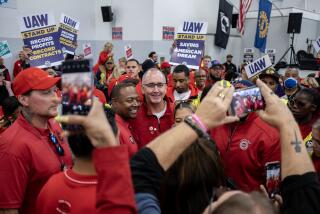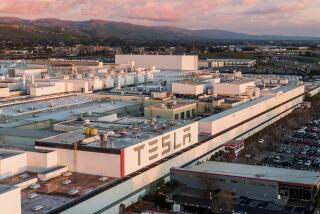AUTO VENTURE AT ROADBLOCK : GM-Toyota Fremont Plant Produces Happy Workers, High-Quality Product--and a Glut of Unsold Chevrolet Novas
- Share via
FREMONT, Calif. — They still play exercise music at the beginning of every shift at the path-breaking joint-venture auto plant here that was designed to infuse Toyota values into a hardened General Motors work force.
Never mind that nobody bothers to do calisthenics now that the novelty of Japanese management has worn off.
Three years after the first Chevrolet Nova rolled off the assembly line here, this GM-Toyota joint venture has confounded the skeptics and is building a top-quality subcompact car on U.S. soil. The Nova has fewer defects per vehicle than any other domestic car, according to surveys by J. D. Power & Associates.
There is just one problem: Chevrolet can only manage to sell about about half the plant’s 250,000-vehicle-a-year capacity.
Workers, by and large, are happy. Absenteeism has plunged to about 3% from 20% when General Motors ran the facility. Empty beer cans have vanished from the plant parking lot; union grievances are down sharply, and brawls among workers are a thing of the past.
In that sense, New United Motors Manufacturing Inc.--NUMMI for short--”is an unqualified success,” says John Hammond, managing partner of J. D. Power, the Westlake Village-based market research concern. “Both partners have met their objectives,” he adds. Toyota has won valuable experience with an American work force and gotten around U.S. import quotas, while GM has gained first-hand knowledge of Toyota’s production system.
NUMMI’s “team concept” is being phased in at General Motors’ problem-plagued plant in Van Nuys; GM just announced another joint venture with Toyota in Australia, and Ford and Chrysler are opening U.S. plants with Mazda and Mitsubishi, respectively.
Production has gone smoothly. But sluggish sales have kept this joint venture from being the showcase that its founders envisioned. Despite plaudits from Consumer Reports magazine (“assembled, fitted and finished as well as any Toyota we’ve seen”), the Nova is languishing in the nation’s showrooms.
NUMMI has cut production three times this year; still, a 222-day supply of Novas is glutting dealers’ lots, according to Ward’s Automotive Reports. (A 60-day supply is considered normal in the automobile industry.) Attrition has cut the number of production workers here by 8%, to around 1,600, but NUMMI has stuck to its commitment to avoid layoffs.
Toyota has day-to-day responsibility for running the plant, which produces Nova four-door sedans and five-door hatchbacks. Since September, 1986, the factory has also produced the Toyota Corolla FX, a three-door hatchback. The Nova is essentially a U.S. version of the Toyota Corolla and is priced about the same.
Union and plant officials at New United Motors are indeed united--in blaming Chevrolet for bungling the Nova’s marketing. “It’s very frustrating,” says Mark T. Hogan, GM’s top man at NUMMI. “I frankly think Chevrolet can be doing more to promote the vehicle.”
“GM really shot themselves in the foot,” adds Joel D. Smith, the United Auto Workers international representative for NUMMI. “First, they pitted this car against four other small cars in Chevrolet’s lineup--the Sprint, Spectrum, Chevette and Cavalier. Then they came up with the brilliant idea of calling it the Nova, which was a dog the first time around.”
Toyota Does Its Part
Even the normally diplomatic Japanese publicly question Chevrolet’s performance. “Whenever I meet with (GM Chairman) Mr. Roger Smith, I say, ‘Please sell more,’ ” says NUMMI President and Chief Executive Kan Higashi. “There are no adequate answers.”
Higashi pointedly adds that Toyota, which took one-third of NUMMI’s production under the Corolla FX nameplate when Nova sales faltered, “is doing a very good job.” Unlike Chevrolet, says Higashi, Toyota’s marketing officials “live with their commitments.”
The Corolla FX is in much tighter supply than the Nova, with just 49 days’ worth of cars in dealer inventories.
How can virtually identical automobiles fare so differently in the marketplace? “It is a question of customer perception,” says Ted Sullivan, director of automobile research at the WEFA Group. Even though the engine, transmission and drive train are produced in Japan, “a lot of people view the Nova as a domestic car and won’t even give it a thought.”
Many consumers agree. “I didn’t even look at the Nova,” says Evan Nichols, a Pacific Telephone computer programmer in Dublin, Calif., who recently bought a Japanese-made Corolla.
Another Corolla buyer, Teri Brager, a Los Gatos, Calif., clinic business manager, said she would have bought a Nova had she known the cars were similar. “I guess I didn’t do enough research,” she says. Critics might say Chevrolet didn’t do enough to reach her.
Of course, the Nova presents Chevrolet with a thorny marketing dilemma. “It’s kind of hard for Chevrolet to advertise that Toyota’s manufacturing system is superior to GM’s,” notes George Nano, a NUMMI worker and head of the UAW’s bargaining committee.
Pricing Criticized
Chevrolet dealers, too, might be reluctant to make too much out of the Japanese pedigree. “The Nova is at the low end of Chevy’s line. If the dealer does a great job of selling Japanese engineering, the Nova buyer will go to Toyota or Honda three years later when he’s ready to trade up,” contends WEFA analyst Sullivan.
Finally, critics contend that Chevrolet miscalculated by overpricing the Nova, which sells for between $8,000 and $11,000--about the same as a Corolla. “The Japanese can afford to charge that much,” Sullivan says. “I’m not sure that Chevy can.”
Chevrolet officials acknowledge that Nova sales are way below expectations but refuse to accept responsibility. “The market is moving away from functional, no-nonsense cars like the Nova,” contends Thomas A. Staudt, general marketing manager of GM’s Chevrolet Motors division. “People today want sporty cars, performance cars, something with a little pizazz.”
Never mind that the utilitarian Hyundai Excel from South Korea was the best-selling nameplate in California with 5.75% of the market during the first eight months of 1987, according to R. L. Polk & Co.
The Hyundai’s popularity underscores another problem facing Nova: The “econobox” segment in which it competes is glutted with new entries that includes the Pontiac Le Mans from South Korea, the Volkswagen Fox from Brazil and the Daihatsu Charade from Japan.
Staudt also denies that highlighting the Nova’s Japanese parentage would reflect poorly on Chevrolet’s domestic offerings. “The Nova is attracting people who otherwise wouldn’t have come into our showrooms,” he says. “We’re very happy to have it.”
Management Praised
In any case, the Nova’s days may be numbered. Although neither Chevrolet nor NUMMI will comment, plant workers say the Nova will be scrapped and that Chevrolet will get another chance with a sportier, more upscale vehicle for the 1989 model year.
“If GM blows it again, they’re going to end up producing nothing but Toyotas at this plant,” warns UAW official Smith.
Smith has nothing but good words for the plant’s Toyota management. “We all communicate a lot with each other. We’re all on the same wavelength,” he says. More importantly, he adds, “nobody has been laid off. That is what we set out to do going in, and that is what we have done.”
Despite that achievement, some workers aren’t satisfied. “The union is garbage,” contends Jesus Garcia. “The union does what the company wants.”
And George Johnson, a veteran from the Fremont plant’s GM days, complains that Toyota has undermined the union’s power by enlisting a cadre of “team leaders”--union members who meet frequently with management and carry instructions down to their five- to seven-member teams.
But the grumblers appear to be in the minority. George Nano, who worked in GM’s plant for 23 years before joining NUMMI, has become a strong believer in Toyota’s philosophy of kaizen, or improvement.
“Here at NUMMI, they send employees--union people--to meet with suppliers and discuss specifications,” he says incredulously. “At GM, I didn’t even know who our suppliers were.”
NUMMI workers, too, are allowed to stop the assembly line if they cannot perform a job in the allotted time. “The philosophy here is: Do it right the first time,” says UAW official Smith.
“Under GM, we used to have literally hundreds of cars in the repair yard,” he continues. “Here, they shut the line down if there are more than 15 cars that need to be repaired.”
One NUMMI production worker, Rick Madrid, takes such pride in his work that he places a business card--another NUMMI touch--on the windshield of every Nova and Corolla FX he encounters. Madrid scribbles a quick thank you on every card--and asks for suggestions on how to build a better car.
Staff Writer Dana Nichols contributed to this story.






